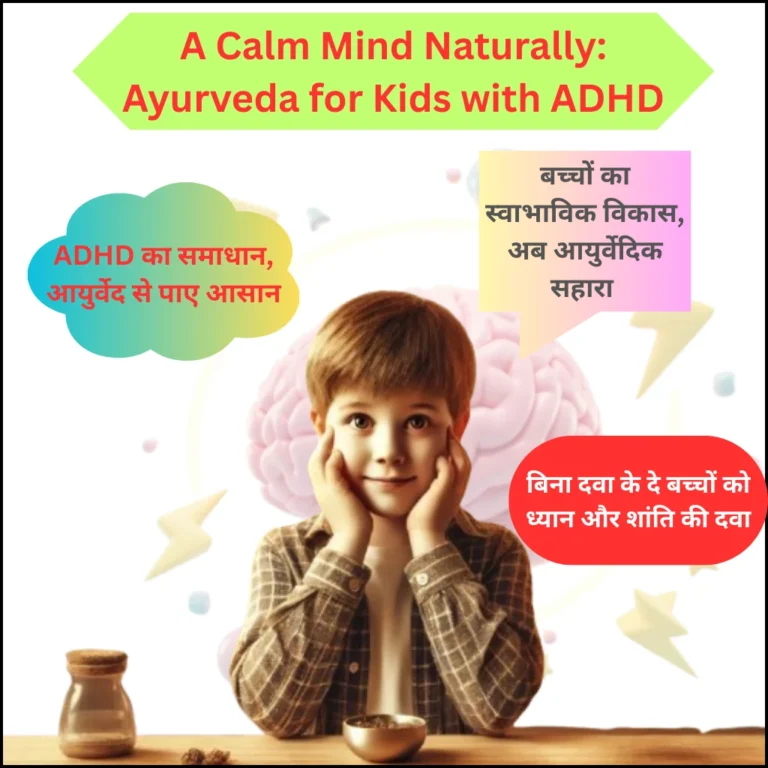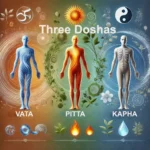ADHD Treatment in Ayurveda
Ayurveda for ADHD in kids offers a safe, holistic approach that goes beyond suppressing symptoms. ADHD (Attention-Deficit/Hyperactivity Disorder) is a growing concern for parents worldwide, with many children struggling with focus, hyperactivity, or emotional outbursts. While conventional treatments often rely on medications with side effects, Ayurveda, India’s 5,000-year-old healing system, addresses the root cause by balancing the body and mind. Instead of labeling children, it identifies imbalances in their natural energies (doshas) and restores harmony through personalized diets, herbs, and therapies. Let’s explore how this ancient wisdom can help your child thrive naturally.
Why Ayurveda? Beyond the “Quick Fix” Mentality
Modern medicine often views ADHD as a “brain chemistry issue” and prescribes stimulants. But Ayurveda asks: “What’s disrupting the body’s natural balance?” It recognizes that every child is unique, and ADHD symptoms stem from imbalances in their doshas (Vata, Pitta, Kapha)—the energies governing physical, mental, and emotional health.
Example:
- A child bouncing off the walls isn’t “broken”—they likely have a Vata imbalance (too much air/space energy).
- A child exploding over minor frustrations may have a Pitta imbalance (excess fire energy).
- A sluggish, unmotivated child often has a Kapha imbalance (heavy earth/water energy).
Ayurveda’s goal? Restore harmony so your child can thrive naturally.
Dosha Imbalances in ADHD: A Detailed Breakdown
1. Vata Imbalance: The Restless Mind
Signs:
- Hyperactivity, fidgeting, racing thoughts.
- Anxiety, irregular sleep, forgetfulness.
- Dry skin, constipation, cold hands/feet.
Root Cause: Vata governs movement and communication. When excessive, it disrupts focus and calm.
Ayurvedic Fix:
- Diet: Warm, oily, grounding foods (e.g., ghee, soups, ripe bananas).
- Herbs: Brahmi (calms nerves), Ashwagandha (reduces anxiety).
- Lifestyle: Regular routines, early bedtime, calming activities like coloring.
2. Pitta Imbalance: The Fiery Temper
Signs:
- Anger, irritability, perfectionism.
- Competitive behavior, skin rashes, excessive thirst.
- Impulsivity (e.g., interrupting others).
Root Cause: Pitta controls metabolism and digestion. Excess heat fuels frustration.
Ayurvedic Fix:
- Diet: Cooling foods (cucumber, coconut, mint).
- Herbs: Shatavari (cools emotions), Yashtimadhu (licorice for soothing).
- Lifestyle: Avoid overheating (skip spicy shows/video games), swimming.
3. Kapha Imbalance: The Foggy Mind
Signs:
- Lethargy, procrastination, clinginess.
- Weight gain, congestion, slow digestion.
- Daydreaming, poor motivation.
Root Cause: Kapha governs structure and stability. Excess causes mental “heaviness.”
Ayurvedic Fix:
- Diet: Light, spicy foods (ginger tea, steamed veggies).
- Herbs: Tulsi (boosts energy), Shankhpushpi (sharpens focus).
- Lifestyle: Morning exercise, limiting screen time, creative play.
Food as Medicine: Ayurvedic Diets for ADHD (With Meal Plans)
Ayurveda teaches that digestion is the foundation of mental health. Processed foods, sugar, and additives clog the body and worsen ADHD. Here’s how to tailor meals to your child’s dosha:
Sample 3-Day Meal Plan for Vata Kids
Day 1:
- Breakfast: Warm oatmeal with almond butter + cardamom.
- Lunch: Khichdi (rice + mung dal) with ghee + steamed carrots.
- Dinner: Sweet potato soup + whole wheat roti.
- Snacks: Dates, warm almond milk.
Sample 3-Day Meal Plan for Pitta Kids
Day 2:
- Breakfast: Coconut yogurt + ripe pears.
- Lunch: Quinoa salad with cucumber + mint raita.
- Dinner: Coconut curry with zucchini + basmati rice.
- Snacks: Coconut water, sweet mango.
Sample 3-Day Meal Plan for Kapha Kids
Day 3:
- Breakfast: Spiced apple porridge (cinnamon + ginger).
- Lunch: Lentil soup with kale + turmeric.
- Dinner: Grilled veggies + barley.
- Snacks: Roasted seeds, herbal teas.
Pro Tip: Use ghee or coconut oil for cooking—healthy fats nourish the brain!
Herbs for ADHD: Science Meets Tradition
Ayurvedic herbs are gentle yet powerful. Here’s how they work:
Brahmi (Bacopa monnieri):
- Role: Repairs neurotransmitters, enhances memory.
- Study: A 2008 trial found Brahmi improved focus in 76% of ADHD kids (Calabrese et al.).
- How to Use: Mix ¼ tsp powder in honey or warm milk.
Ashwagandha (Withania somnifera):
- Role: Lowers cortisol (stress hormone), stabilizes mood.
- Study: A 2017 paper showed reduced anxiety in 68% of children (Choudhary et al.).
- How to Use: ½ tsp powder in bedtime milk.
Shankhpushpi (Convolvulus pluricaulis):
- Role: Boosts acetylcholine (brain chemical for focus).
- How to Use: 2-3 drops of syrup in morning meals.
- Safety Note: Always consult an Ayurvedic doctor for doses—kids need smaller amounts
Panchakarma for Kids: Safe Detox Therapies
Panchakarma isn’t just about detox—it’s a reset for the nervous system. Child-friendly therapies include:
Shirodhara:
- Process: Warm herbal oil flows over the forehead in rhythmic strokes.
- Benefits: Balances Vata, calms anxiety, improves sleep.
- Parent Review: “My son slept through the night after just 3 sessions” – Priya, Mumbai.
Abhyanga (Oil Massage):
- Process: Full-body massage with sesame or coconut oil.
- Benefits: Grounds hyperactivity, boosts circulation, builds parent-child bonding.
- Tip: Use bedtime massage to wind down.
Nasya:
- Process: 2 drops of medicated oil in each nostril.
- Benefits: Clears sinuses, enhances mental clarity.
- Science: A 2020 study noted improved attention spans in 70% of kids (Journal of Ayurveda).
Important: Panchakarma must be supervised by an MD Ayurveda doctor. Avoid DIY!
Daily Routines: Small Habits, Big Changes
Ayurveda thrives on consistency. Try these routines:
Morning:
- Wake at 6 AM (aligns with natural rhythms).
- Tongue scraping + warm lemon water (detox).
- 10-minute yoga (e.g., Balasana/Child’s Pose for calm).
After School:
- Outdoor play (sunlight boosts serotonin).
- Herbal tea (try chamomile + fennel for digestion).
Bedtime:
- Warm milk with turmeric + cardamom.
- Gratitude journaling (write 1 happy moment).
Real Stories: How Ayurveda Transformed Lives
Case 1: Arjun’s Journey from Chaos to Calm
Age: 8 | Dosha: Vata-Pitta
Symptoms: Hyperactivity, rage tantrums, poor grades.
Ayurvedic Plan:
- Diet: Warm meals every 2 hours (no cold snacks).
- Herbs: Brahmi + Ashwagandha.
- Therapies: Weekly Shirodhara.
Result: In 3 months, Arjun’s focus improved, and his teacher called him “a joy to teach.”
Case 2: Riya’s Escape from Brain Fog
Age: 10 | Dosha: Kapha
Symptoms: Daydreaming, low energy, weight gain.
Ayurvedic Plan:
- Diet: Light, spicy meals + ginger tea.
- Herbs: Shankhpushpi + Tulsi.
- Therapies: Daily Abhyanga.
Result: Riya joined a dance class and became the “most active kid in school!”
Conclusion: Empowering Your Child’s Potential
ADHD isn’t a flaw—it’s a sign your child’s body needs rebalancing. Ayurveda offers tools to nurture their mind, body, and spirit without harsh chemicals. Start small: swap one snack for a brain-boosting alternative, try a 5-minute massage, or add Brahmi to their milk. Celebrate progress, not perfection.


